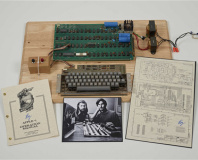My First PC
The bit-tech team reveals their first experience of one of the most important inventions of the last 30 years. Be sure to let us know about your first PC in the comment thread.James Gorbold, Editor
First PC: IBM PC 5150 I was lucky growing up, as my father worked at the cutting edge of the electronics industry during the 1970s and 1980s, designing test and measurement devices. This meant that I was exposed to some of the first PCs, namely the Commodore PET and the now more famous IBM 5150, almost a decade before most other people in the UK.
I was lucky growing up, as my father worked at the cutting edge of the electronics industry during the 1970s and 1980s, designing test and measurement devices. This meant that I was exposed to some of the first PCs, namely the Commodore PET and the now more famous IBM 5150, almost a decade before most other people in the UK.However, while my father used these PCs for his job, I was more interested in playing games that were rendered in ASCII such as Batalia and Ikebukuro; I later learned to write my own text adventures in BASIC. Seeing the working IBM 5150 that we photographed for this feature was an emotional trip down memory lane. If I hadn’t had access to these PCs all those years ago, I may not have become an IT journalist and later the editor of bit-tech.
Clive Webster, Deputy Editor
First PC: 400MHz AMD K6-2 Towards the end of the last millennium, my first PC was, on paper at least, awesome. It had a 400MHz AMD K6-II processor, a 10GB hard disk and an ATI Rage Maxx GPU. However, as the PC ran Windows 95, it was constantly breaking down and the more I researched fixes to the various problems, the more I discovered that headline specs don’t tell the whole story. For example, the awesome-sounding graphics chip was integrated onto the motherboard and was the first component to be retired (in favour of a £300 GeForce 3 card). Despite the research I’d carried out before advising my parents about which PC to buy, we ended up with a PC that didn’t last long. All my tinkering and fixing gave me enough knowledge to realise that if I wanted a fast PC that would last, I’d have to build it myself. Eleven years on, I’m still doing exactly that.
Towards the end of the last millennium, my first PC was, on paper at least, awesome. It had a 400MHz AMD K6-II processor, a 10GB hard disk and an ATI Rage Maxx GPU. However, as the PC ran Windows 95, it was constantly breaking down and the more I researched fixes to the various problems, the more I discovered that headline specs don’t tell the whole story. For example, the awesome-sounding graphics chip was integrated onto the motherboard and was the first component to be retired (in favour of a £300 GeForce 3 card). Despite the research I’d carried out before advising my parents about which PC to buy, we ended up with a PC that didn’t last long. All my tinkering and fixing gave me enough knowledge to realise that if I wanted a fast PC that would last, I’d have to build it myself. Eleven years on, I’m still doing exactly that.Ben Hardwidge, Features Editor
First PC: Sinclair PC200 The first PC I used was an Apricot F1 clone machine that my dad kept for work in 1984, but the first PC we had at home was a Sinclair PC200 in 1989. It was awful by modern standards, with an 8MHz 8086 CPU, 512KB of RAM, no hard disk and a terrible CGA graphics card, which ran all my graphical games at 320 x 200 with four colours. Magenta, cyan, black and white was the usual combo.
The first PC I used was an Apricot F1 clone machine that my dad kept for work in 1984, but the first PC we had at home was a Sinclair PC200 in 1989. It was awful by modern standards, with an 8MHz 8086 CPU, 512KB of RAM, no hard disk and a terrible CGA graphics card, which ran all my graphical games at 320 x 200 with four colours. Magenta, cyan, black and white was the usual combo.Even so, I spent a massive amount of my childhood tinkering with it, from writing text adventures in GWBasic to playing games. My favourites were Targhan, Death Track, Speedball, Wizard Warz, and the old Sierra and LucasArts adventures. I also typed all my GCSE essays on the character-based Letter Perfect word processor.
Joe Martin, Games Editor
First PC: IBM P133 My first PC was an IBM P133; it was one of those beige desktop units that was laid on its side with the monitor positioned on top – a setup that you don’t see much any more. I don’t recall the other specs, and I can only remember the speed of the CPU because it was written on a sticker next to the CD drive. I fiddled with that sticker a lot while I swapped in and out the six CDs that held my favourite RPG, Betrayal in Antara. The P133 wasn’t the first machine to get me interested in computers though – that honour goes to the Amiga A500+ that preceded it. I may be the least technically competent member of the Custom PC staff, but even I was able to learn the basics of making my own simple games with the Amiga’s AMOS programming language. Later, I used PC software such as Klik ‘n’ Play to experiment further on the family IBM PC.
My first PC was an IBM P133; it was one of those beige desktop units that was laid on its side with the monitor positioned on top – a setup that you don’t see much any more. I don’t recall the other specs, and I can only remember the speed of the CPU because it was written on a sticker next to the CD drive. I fiddled with that sticker a lot while I swapped in and out the six CDs that held my favourite RPG, Betrayal in Antara. The P133 wasn’t the first machine to get me interested in computers though – that honour goes to the Amiga A500+ that preceded it. I may be the least technically competent member of the Custom PC staff, but even I was able to learn the basics of making my own simple games with the Amiga’s AMOS programming language. Later, I used PC software such as Klik ‘n’ Play to experiment further on the family IBM PC.Paul Goodhead, Staff Writer
First PC: Anonymous 486-era PC My first PC cost around £2,000 and was disappointing in almost every way. It was slow, loud, nothing ran on it and we had no Internet connection. My only fond memory is of playing Descent on it, though I was so young that all I did was blast away at anything that moved until I’d used up all my missiles.
My first PC cost around £2,000 and was disappointing in almost every way. It was slow, loud, nothing ran on it and we had no Internet connection. My only fond memory is of playing Descent on it, though I was so young that all I did was blast away at anything that moved until I’d used up all my missiles.It also needed occasional upgrading – an arduous and expensive task that involved leaving it at the local PC shop for a week. It would then come back plagued with compatibility and stability issues before being returned to the shop. This put me off PC gaming, pushing me towards consoles for the next few years. It wasn’t until I saw people gaming over a broadband connection at uni that I saw the potential for PC gaming and built my first rig.

MSI MPG Velox 100R Chassis Review
October 14 2021 | 15:04









Want to comment? Please log in.